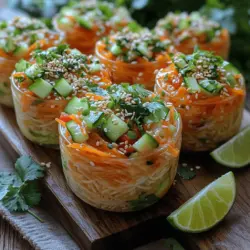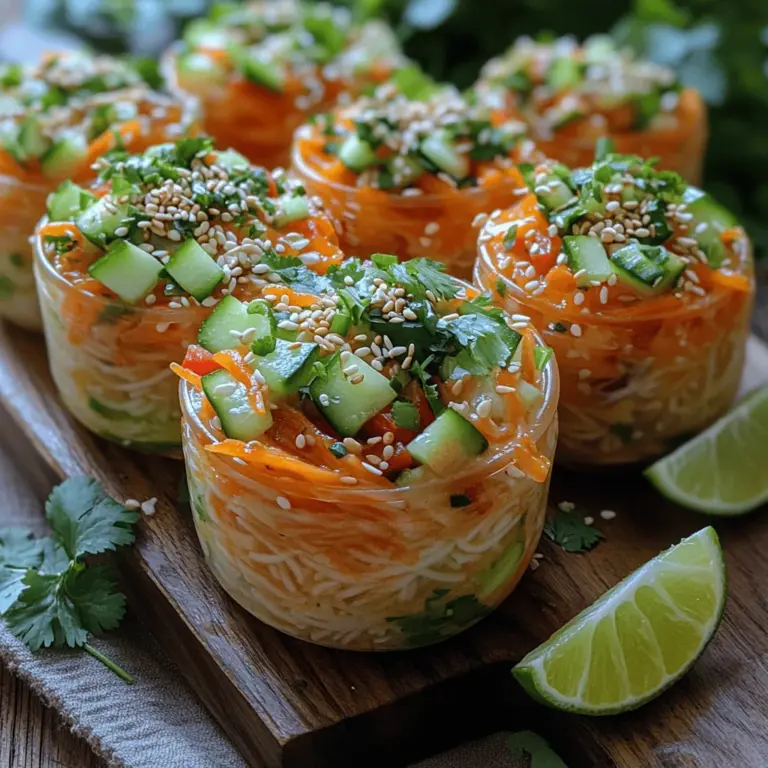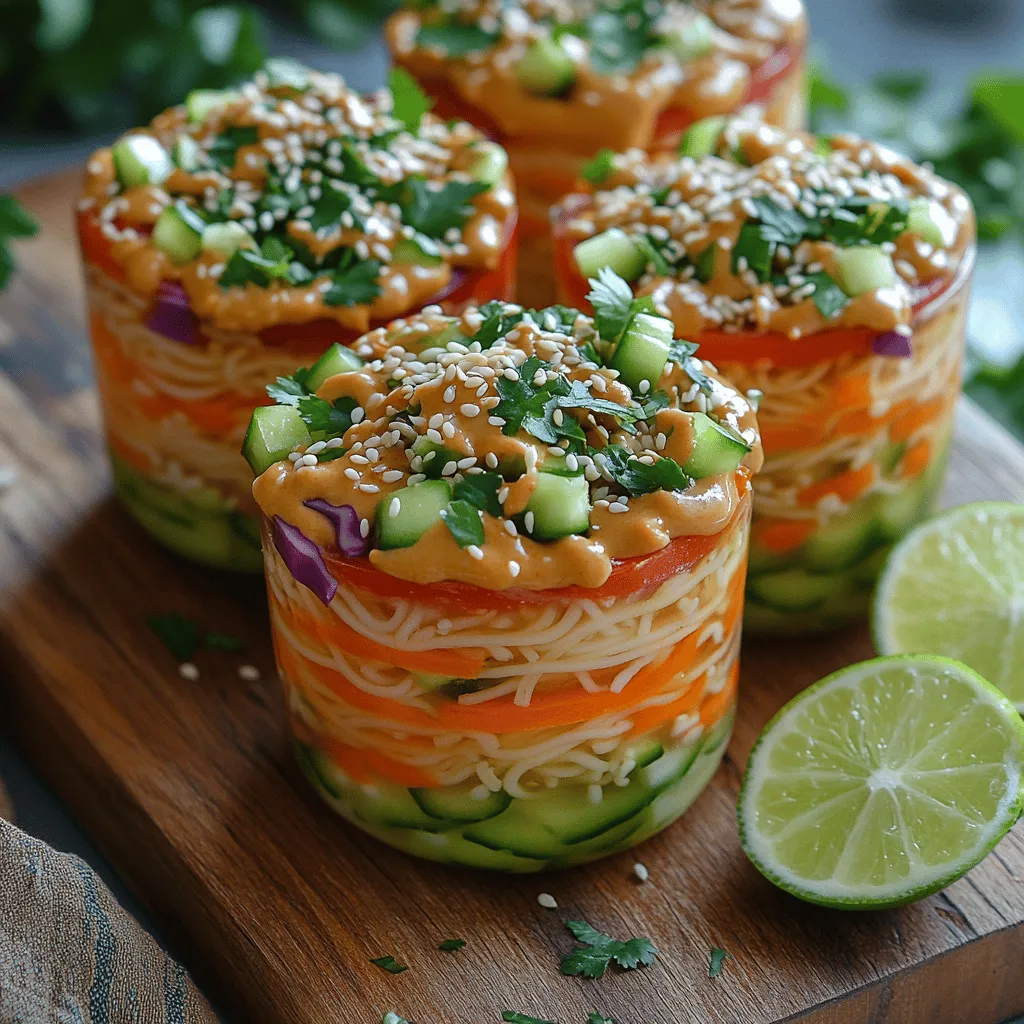Introduction
Thai cuisine has gained immense popularity around the globe, and for good reason. Known for its vibrant flavors, use of fresh ingredients, and delightful balance of sweet, salty, spicy, and sour, Thai food offers an array of culinary experiences that can suit any palate. One dish that embodies these qualities and stands out for its refreshing taste is Chilled Thai Peanut Noodle Cups. This recipe is not only easy to make but also healthy, making it a fantastic option for summer gatherings, picnics, or even a light lunch at home.
Chilled Thai Peanut Noodle Cups combine the richness of a creamy peanut sauce with the crisp freshness of colorful vegetables, all served in a convenient cup form. This dish is particularly appealing as it can be prepared in advance, allowing you to spend more time with your guests rather than being stuck in the kitchen. Whether you’re hosting a barbecue, a family reunion, or simply looking to impress your friends with your cooking skills, these noodle cups are sure to be a hit.
The Essence of Thai Flavors
At the heart of Thai cuisine is a unique blend of key ingredients that create its signature flavors. Thai cooking revolves around fresh herbs and spices such as lemongrass, galangal, and kaffir lime leaves, which infuse dishes with aromatic qualities that are both invigorating and comforting. In addition, ingredients like fish sauce, lime juice, and tamarind paste contribute to the complexity of flavors that Thai dishes are known for.
One of the most defining characteristics of Thai cooking is the balance of flavors. Dishes often harmonize sweet, spicy, salty, and tangy elements, creating a multi-dimensional taste experience. For instance, a typical peanut sauce used in Thai dishes achieves this balance by combining the nuttiness of peanuts with the sweetness of sugar, the saltiness of soy sauce, and the tanginess of lime juice.
Fresh vegetables are another essential component of Thai cuisine. Not only do they provide a burst of color and texture, but they also enhance the overall flavor profile of the dish. In our Chilled Thai Peanut Noodle Cups, ingredients like red bell pepper, cucumber, carrots, and red cabbage add crunch and freshness, making each bite exciting and refreshing.
Understanding the Peanut Sauce
At the core of Chilled Thai Peanut Noodle Cups lies the peanut sauce, which plays a crucial role in bringing the dish together. This rich and creamy sauce is made primarily from peanut butter, which provides a delectable nutty flavor and creamy texture. Peanut butter is not only delicious but also packed with nutritional benefits; it’s a good source of protein, healthy fats, and essential vitamins and minerals, making it a wholesome addition to any meal.
When making the peanut sauce, there are several variations you can consider to suit dietary preferences or restrictions. For individuals who need a gluten-free option, substituting regular soy sauce with tamari is a simple way to maintain the flavor while adhering to dietary needs. Additionally, if you prefer a vegan alternative, you can replace honey with maple syrup or agave nectar while still achieving the desired sweetness.
Adjusting the spice level of the peanut sauce is also easy. If you enjoy a bit of heat, incorporating some sriracha or chili paste can elevate the flavor profile and add that signature Thai kick. Conversely, for those who prefer a milder taste, you can simply omit the spicy elements. This versatility allows you to customize the dish to your liking, making it even more appealing.
Selecting the Right Noodles
The choice of noodles is pivotal in making the perfect Chilled Thai Peanut Noodle Cups. While there are numerous types of noodles available, two of the most suitable options for this dish are rice noodles and soba noodles.
Rice noodles, made from rice flour and water, are gluten-free and have a light, chewy texture that pairs beautifully with the peanut sauce. They are commonly used in many Thai dishes, such as Pad Thai or noodle salads, making them an authentic choice. On the other hand, soba noodles, made from buckwheat flour, offer a nutty flavor and are rich in protein and fiber, making them a nutritious alternative.
When cooking noodles for this recipe, achieving the perfect texture is essential. Follow the package instructions for cooking time but keep in mind that overcooking can lead to mushy noodles that won’t hold up well in the cups. Aim for al dente noodles that retain a slight firmness, allowing them to hold their shape when combined with the sauce and vegetables.
After cooking the noodles, it’s crucial to rinse them under cold water to stop the cooking process. This not only cools the noodles down for the chilled presentation but also prevents them from sticking together, which can be a common issue with cooked noodles.
Ingredients Breakdown
To create the Chilled Thai Peanut Noodle Cups, you’ll need a selection of fresh ingredients that come together to provide a burst of flavor and nutrition. Here’s a detailed look at each ingredient used in the noodle cups:
– Red Bell Pepper: This vibrant vegetable adds a sweet crunch to the dish. Rich in vitamins A and C, red bell peppers contribute to improved immune function and skin health. Their bright color also enhances the visual appeal of the noodle cups, making them more enticing.
– Cucumber: Known for its refreshing taste and high water content, cucumber is an excellent addition to the noodle cups. It provides a satisfying crunch while being low in calories, making it a great choice for those looking to maintain a healthy diet. Additionally, cucumbers are a good source of antioxidants and promote hydration.
– Carrots: These root vegetables bring a natural sweetness and vibrant color to the dish. Carrots are loaded with beta-carotene, which the body converts into vitamin A, promoting good vision and skin health. Their crunchy texture adds a delightful contrast to the soft noodles, enhancing the overall eating experience.
– Red Cabbage: With its beautiful purple hue, red cabbage adds not only color but also a wealth of nutrients. It’s rich in vitamins C and K, as well as fiber, which supports digestive health. The crunchy texture of red cabbage complements the noodles and other vegetables, providing a satisfying bite.
These ingredients come together to create a visually stunning and flavorful dish that is not only pleasing to the eye but also nourishing to the body. By carefully selecting and preparing each element, you will create Chilled Thai Peanut Noodle Cups that are not only delicious but also healthy and refreshing.
In the next part of this article, we will delve into the step-by-step instructions for preparing these Chilled Thai Peanut Noodle Cups, ensuring that you can recreate this delightful dish with ease. Stay tuned for tips on how to assemble the noodle cups and make the most of this vibrant, Thai-inspired recipe!
Fresh Herbs: The Aromatic Flavor Boost
When it comes to enhancing the flavors of Chilled Thai Peanut Noodle Cups, fresh herbs are essential. Cilantro and green onions (scallions) add a vibrant freshness that elevates the creamy, nutty peanut sauce while providing a pleasing contrast to the richness of the noodles. Cilantro provides a citrusy, slightly peppery flavor that is quintessential to Thai cuisine, while green onions contribute a mild onion flavor with a hint of sweetness. Together, they create a well-rounded taste profile that keeps each bite interesting.
Additionally, lime wedges and sesame seeds play a pivotal role in enhancing this dish. The zesty acidity of lime adds brightness, cutting through the richness of the peanut sauce. A squeeze of fresh lime just before serving brings a refreshing contrast and a burst of flavor that elevates the entire dish. Meanwhile, sesame seeds not only add a subtle nutty crunch but also enhance the presentation, making your noodle cups visually appealing.
Step-by-Step Preparation Guide
Making the Peanut Sauce
1. Gather Your Ingredients: Start by gathering all the ingredients needed for the peanut sauce, which typically includes peanut butter, soy sauce, lime juice, honey or maple syrup, garlic, ginger, and a bit of water.
2. Mix the Ingredients: In a medium bowl, combine 1 cup of creamy peanut butter with 1/4 cup of soy sauce, 2 tablespoons of fresh lime juice, 2 tablespoons of honey or maple syrup, 2 cloves of minced garlic, and 1 teaspoon of grated ginger.
3. Whisk Until Smooth: Use a whisk to blend all the ingredients until the mixture is smooth and creamy. As you whisk, gradually add in cold water, one tablespoon at a time, until you reach your desired consistency. The sauce should be thick yet pourable, allowing it to coat the noodles nicely.
4. Taste and Adjust: Always taste your sauce before using it. You may want to adjust the flavors by adding more lime juice for acidity, honey for sweetness, or soy sauce for saltiness.
Cooking and Cooling the Noodles
1. Boil the Noodles: Bring a large pot of salted water to a boil. Add your choice of noodles — rice noodles are traditional, but you can use other types like soba or whole wheat noodles for a healthier option. Cook according to the package instructions, usually around 6-8 minutes.
2. Drain and Rinse: Once cooked, drain the noodles in a colander and rinse them under cold water to stop the cooking process and cool them down.
3. Toss with Oil: To prevent the noodles from sticking together, drizzle a teaspoon of sesame oil over them and toss gently to coat.
Importance of Timing in Noodle Preparation
Timing is crucial when cooking noodles for your Chilled Thai Peanut Noodle Cups. Overcooking can lead to mushy noodles that don’t hold their shape. Set a timer and keep an eye on your noodles as they approach the end of their cooking time. Once drained and rinsed, make sure to handle them gently to avoid breaking.
Combining Ingredients: Achieving the Right Balance of Flavors
1. Mix the Noodles with Sauce: In a large mixing bowl, combine the cooled noodles with the prepared peanut sauce. Use tongs or your hands to gently toss until the noodles are evenly coated.
2. Incorporate Fresh Herbs: Fold in chopped cilantro and sliced green onions, reserving a bit for garnish. This step is crucial as it ensures that the herbs are distributed evenly, lending their aromatic essence throughout the dish.
3. Taste Again: Before assembling, taste the mixture once more. Adjust the seasoning if necessary, adding a pinch of salt or more lime juice according to your preference.
Assembling the Noodle Cups
1. Prepare Muffin Tins: Lightly grease a muffin tin or use silicone liners for easy removal. This step will help in achieving neat and tidy noodle cups.
2. Fill the Cup Molds: Spoon the noodle mixture into each muffin tin mold, packing them down gently to create a firm base and ensuring they hold their shape. Leave a little space at the top to allow for garnishes.
3. Garnish Before Chilling: Sprinkle the remaining green onions and cilantro on top for a pop of color.
Chilling the Noodle Cups
1. Refrigerate: Once assembled, cover the muffin tin with plastic wrap or a lid and place it in the refrigerator. Chilling the noodle cups for at least 30 minutes allows the flavors to meld and enhances the overall taste.
2. Benefits for Flavor and Presentation: Chilling not only improves the flavor but also helps the noodle cups maintain their shape when served. The refreshing cold temperature makes them a perfect dish for warm weather or outdoor gatherings.
Presentation and Serving Suggestions
Chilled Thai Peanut Noodle Cups can be served in various creative ways. Here are a few suggestions to make your dish not only delicious but also visually appealing:
1. Plating: Carefully remove the noodle cups from the muffin tin and place them on a serving platter. You can garnish with additional cilantro, sesame seeds, and lime wedges for a pop of color.
2. Serving Individual Portions: Alternatively, you can leave the noodle cups in their muffin tins for a fun, interactive presentation. Guests can simply grab their own cup, making it a perfect appetizer for parties or potlucks.
3. Pairing Suggestions: Pair these noodle cups with a light drink, such as iced tea or coconut water, to complement the peanut sauce. You might also consider serving them alongside a fresh salad or spring rolls for a complete meal.
4. Perfect for Gatherings: The appeal of these cups at gatherings lies in their bite-sized nature and vibrant flavors. They are easy to prepare in advance, freeing you up to enjoy the occasion with your guests.
Nutritional Information
Understanding the nutritional profile of your Chilled Thai Peanut Noodle Cups can help you make informed choices:
– Calories: Each noodle cup contains approximately 200 calories.
– Macronutrients: Expect around 10 grams of protein, 10 grams of fat (mostly from the peanut butter), and 25 grams of carbohydrates.
– Vitamins and Minerals: This dish is rich in vitamins A, C, and K from the fresh herbs, as well as minerals like magnesium and potassium from the peanuts and noodles.
Health Benefits
Including Chilled Thai Peanut Noodle Cups in your diet can offer various health benefits. Peanuts are an excellent source of protein and healthy fats, contributing to satiety and overall health. The fresh herbs provide antioxidants and anti-inflammatory properties, while the lime juice aids digestion. Moreover, this dish can easily be adapted to fit different dietary needs, such as gluten-free by using rice noodles or vegan by omitting honey.
Conclusion
Chilled Thai Peanut Noodle Cups are a delightful fusion of flavors and textures, making them a versatile dish for any occasion. Their ease of preparation, vibrant taste, and appealing presentation make them a hit at gatherings or as a refreshing weeknight meal.
Feel free to experiment with variations, such as adding grilled chicken, tofu, or different vegetables to the mix. The creative possibilities are endless, allowing you to tailor the recipe to your taste and dietary preferences.
Sharing these noodle cups with family and friends not only brings joy but also showcases the beauty of homemade cuisine. So grab your ingredients, follow the steps, and enjoy a delicious culinary experience that will leave a lasting impression.


